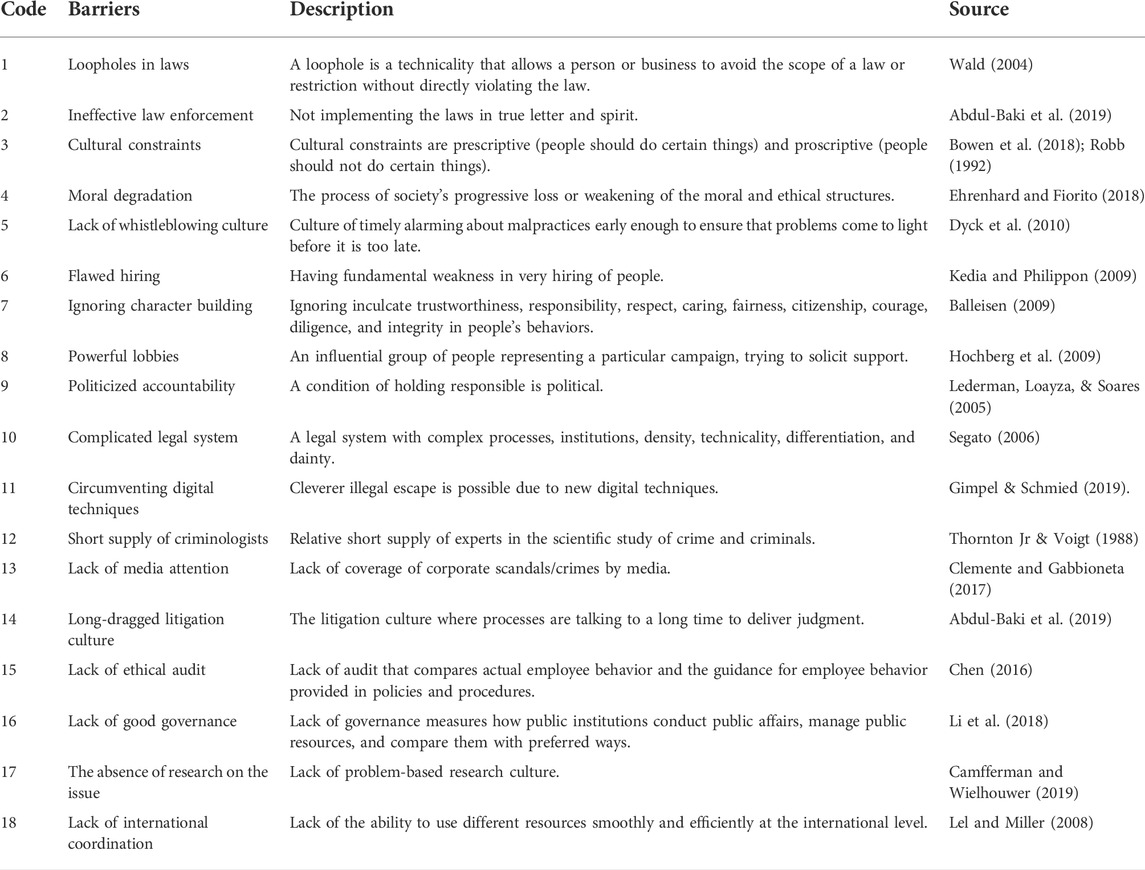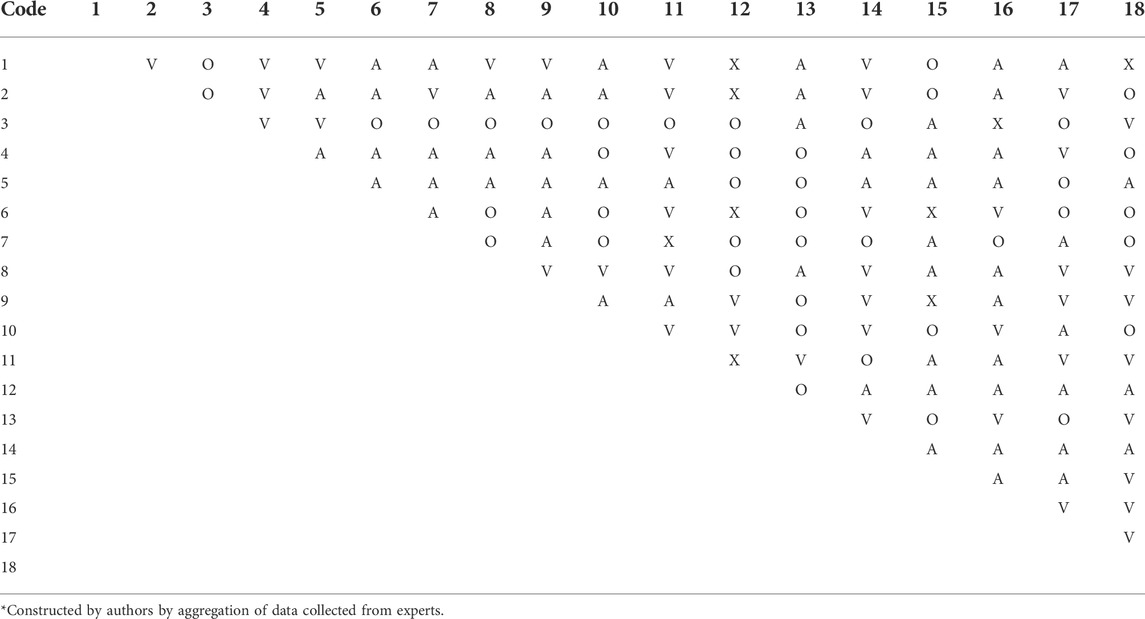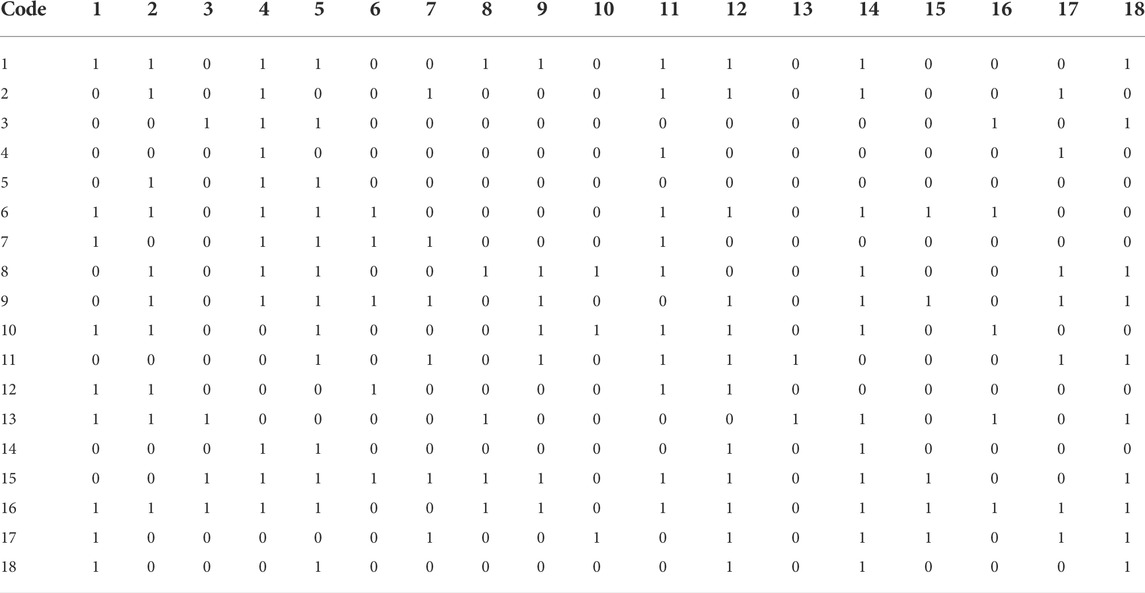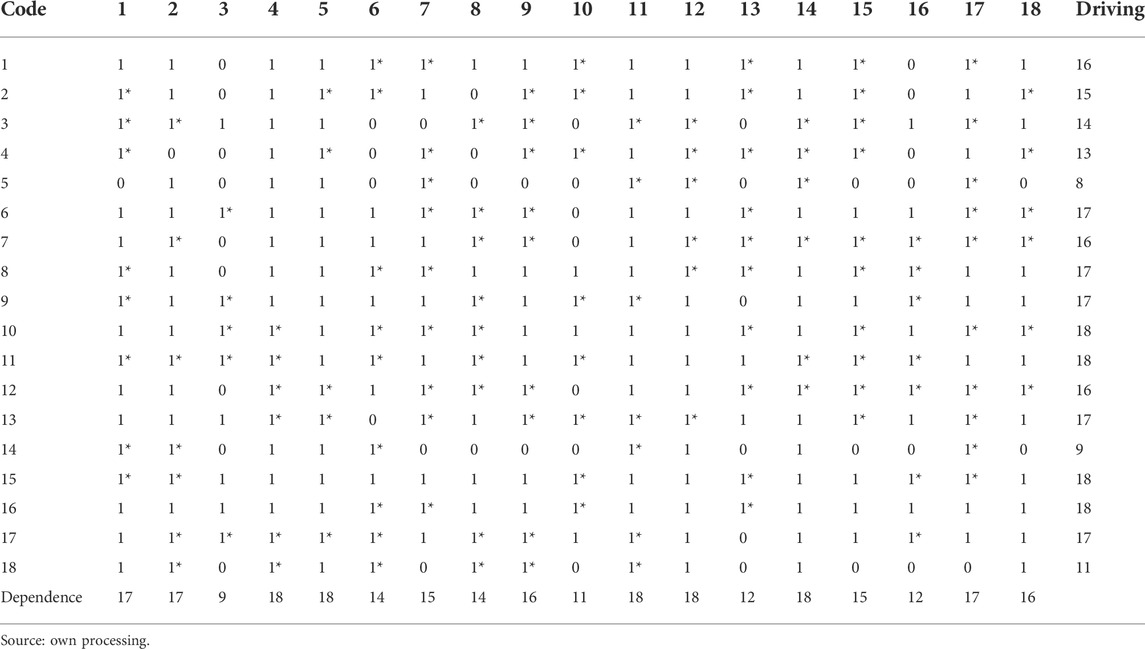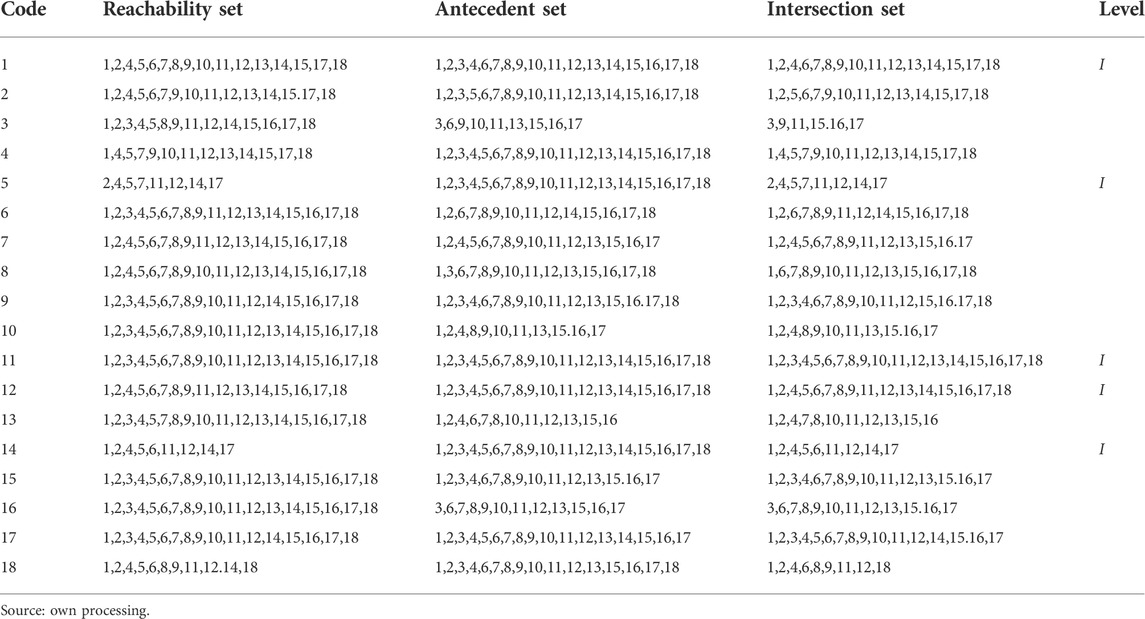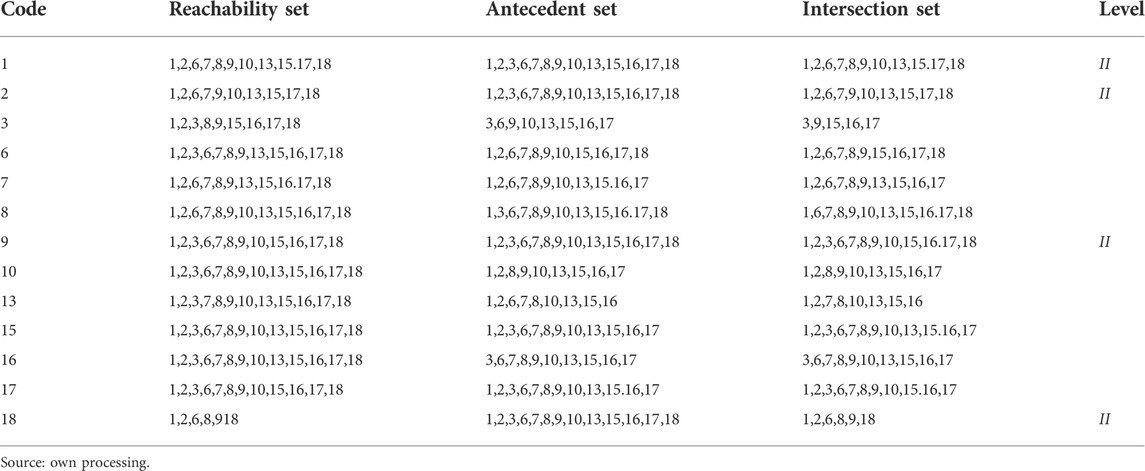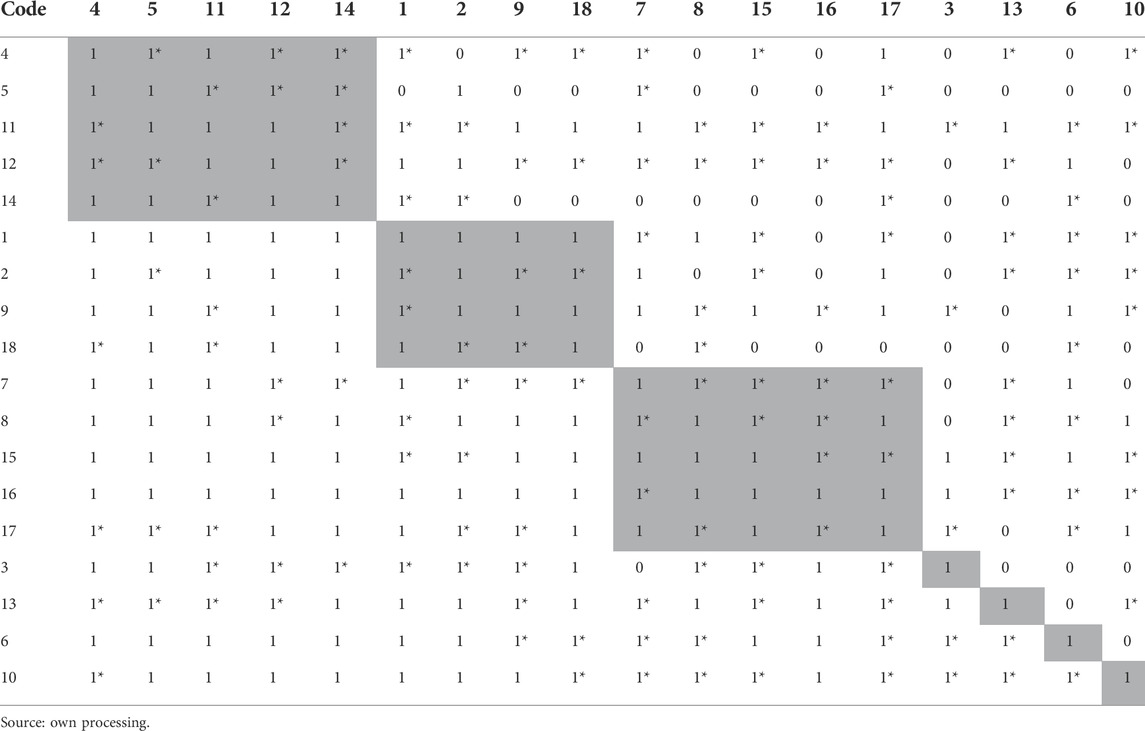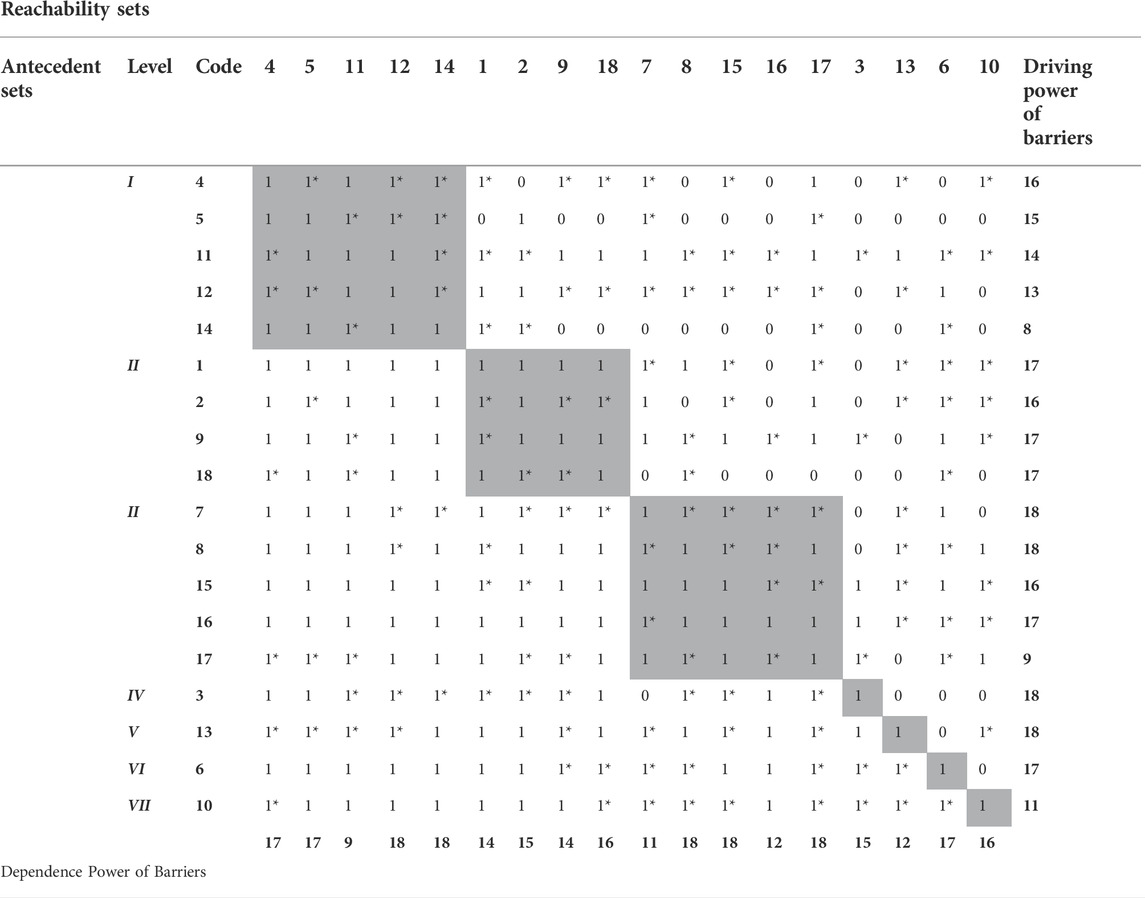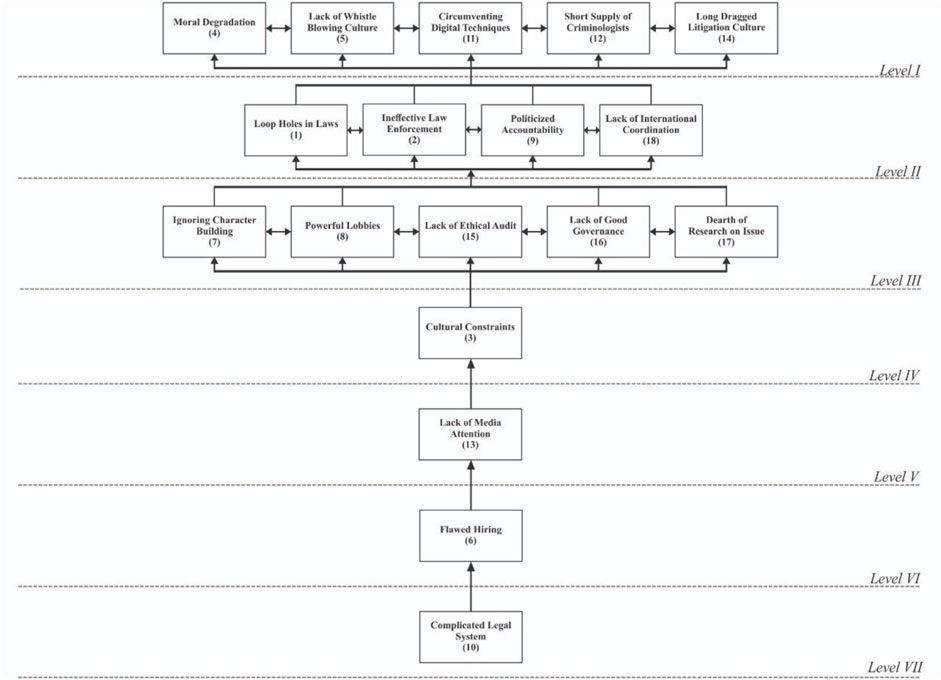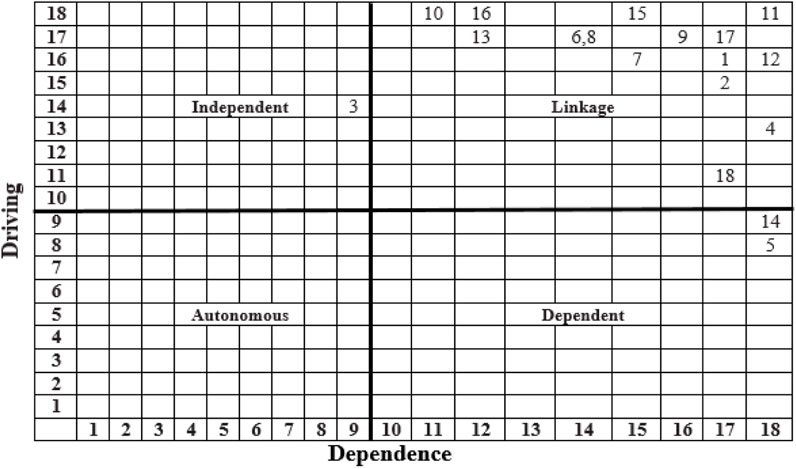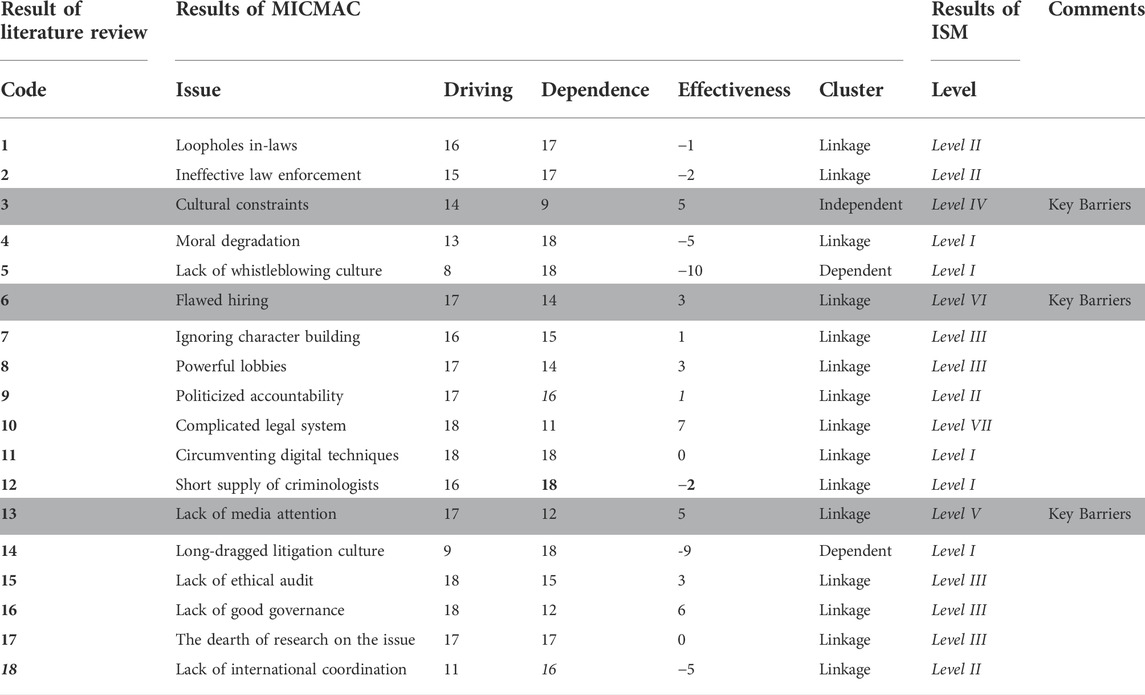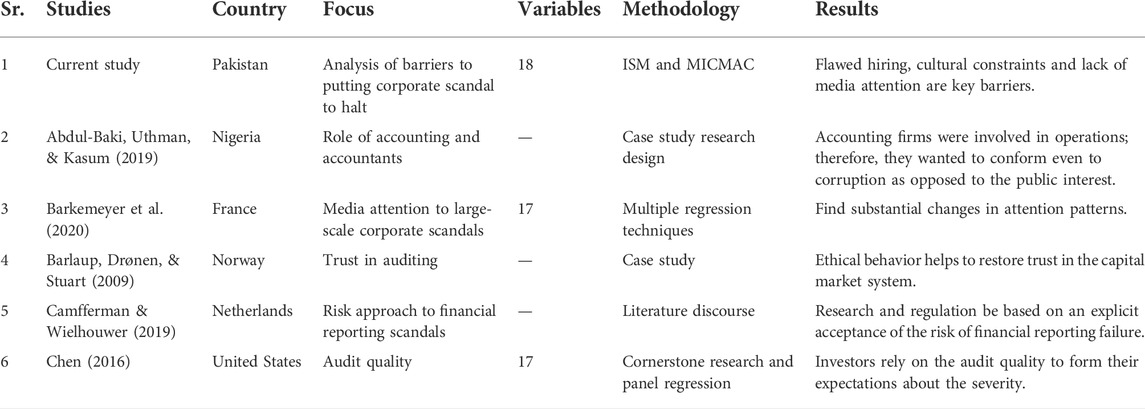- 1School of Economics and Management, Huizhou University, Huizhou, China
- 2School of Economics and Management, Nanjing University of Science and Technology, Nanjing, China
- 3Hailey College of Banking and Finance, University of the Punjab, Lahore, Pakistan
- 4Institute of Business and Management, University of Engineering and Technology, Lahore, Pakistan
- 5Department of Finance, Babes-Bolyai University, Cluj-Napoca, Romania
Dealing with expropriating investors’ money is a demanding issue in the corporate sector. This study aims to unveil the barriers to putting expropriations to halt, extract the structure underlying the relationships among barriers, and classify them. The study design entails a literature survey, primary data collection, modeling of the issue, and analysis. This study uses Interpretive Structural Modeling (ISM) and Matriced Impacts Cruise’s Multiplication Appliquée a UN Classement (MICMAC) to address this issue. The study uses a non-probability-based purposive sampling technique. The data were collected from a panel of experts consisting of 12 chief financial officers recruited from companies listed on the Pakistan Stock Exchange, Pakistan, from July to September 2022. We find that a “complicated legal system” is the most critical barrier to putting expropriations to a halt, followed by barriers such as “flawed hiring” and “lack of media attention.” In addition, the least critical are barriers such as “loopholes in laws,” “ineffective law enforcement,” “politicized accountability,” and “lack of international coordination.” It is an original and valuable study based on real-time data collected from the respondents having hands-on helm of the companies’ financial affairs. This is a seminal practical study for policymakers and other stakeholders to understand the barriers to halting corporate scandals and explain expropriations.
1 Introduction
The transition from the manual production of fewer products to mass machine production resulted in a complicated business organization, a company. With the emergence of this form of business organization, many legal, structural, and operational changes erupted in the business world. In exploring history, one can find financial panic roughly every 20 years: 1819, 1836, 1857, 1873, 1893, 1907, 1929, 1987, and 2008 (Brean et al., 2008). The literature is rich with this information, for example, corruption as an institutionalized practice in Nigeria (Abdul-Baki et al., 2019); perceived crisis response during company scandal in the US. and Germany (Bowen et al., 2018); finance capitalism, scandal, and financial crises in a Danish bank failure (Hansen, 2012); the devastating impact of the corporate scandal on housing investment in China (Niu et al., 2019); corporate governance reforms in the United States and Italy after financial accounting scandals (Sorensen and Miller, 2017); scandal from the island of Sri Lanka (Uddin et al., 2017); and the role of ESG assessment in predicting corporate scandals (Utz, 2019).
These panics created company failures, and the literature is rich with examples, such as Adelphia (Barlaup, Drønen and Stuart, 2009), Arthur Andersen (Blouin, Grein, and Rountree, 2007), Bristol-Myers Squibb (Warin and Jaffe, 2007), Computer Associates , Enron (Li, 2010), HealthSouth (Sanchez and Zhang, 2012), Marsh and McLennan (Barnabas, Anbarasu, and Clifford, 2010), Parmalat (Melis, 2005), PNC Financial Services (Sangani, 2017), Qwest (Rijsenbilt and Commandeur, 2013), Waste Management (Hewiagh, Ramakrishnan, Yap and Tan, 2021), WorldCom (Sidak, 2003), Xerox (Gottschalk, 2019), Volkswagen (Li et al., 2018), SanLu (Charlebois et al., 2013), Satyam Computers (Bhasin, 2013), Tragedy of Bhopal (Mishra et al., 2009), Bank of Credit and Commerce International (Herring, 2004), and Bearings Bank (Herring, 2004). These monsters defrauded/stolen/eaten up/expropriated trillions of dollars of investors through tunneling, channel-stuffing, cookie-jar accounting, fake sales, fake financial statements, inflating/understating revenues/assets/liabilities, bribery, money laundering, drug trafficking, supporting terrorism, capacity swapping, insider trading, false disclosures, manipulation of share prices, mark-to-mark accounting, complicated cash management, and heavy personal loans/expenses. As mentioned earlier, the corporate financial scams are making mouths at managers, regulators, and/or champions of corporate governance. It is crucial to halt corporate scams. It is a do-or-die issue for corporations that have ever been a green area for research. Contemporary researchers have analyzed different aspects/dynamics of these scams, but barriers to halting them have been neither unearthed nor analyzed scientifically. This research gap needs to be studied on a priority basis. Studying these topics is necessary; ours is one of the seminal studies extending the theoretical frontiers of the domain.
As a starting point for halting these schemes, it is crucial to identify the barriers that hindered stakeholders’ efforts to arrest the situation. Therefore, the objectives of the study are as follows: 1) preparing a list of barriers to halting corporate expropriations, 2) determining the interbarrier relationships, 3) imposing a structural hierarchy on the complexity of relations, 4) building a structural model, and 5) discussing the structural model qua reality. To achieve the objectives mentioned earlier, a wide array of methods were chosen, such as those mentioned in/or used by Shaukat et al., 2021; Yu, Draghici, Negulescu and Ain, 2022; Li, Dongling, Baig and Zhang, 2022; Zhou et al., 2022; Aman et al. (2022); Al Halbusi, Al-Sulaiti, and Al-Sulaiti, 2022; Paulson et al., 2021; LBD, 2021; Farzadfar et al., 2022; and Abbasi et al., 2021). An Interpretive Structural Modeling (ISM) was chosen and has been applied in various areas (Warfield, 1973; Warfield, 1974; Sushil, 2017). It is a primary data-based technique in which mental models of members of a focus group (experts in this case) are captured using a matrix type of questionnaire, and the responses are aggregated by majority rule; ISM provides the opportunity to thoroughly understand the situation using lost statistical techniques (Chidambaranathan et al., 2009). It is a significant study because losses from corporate financial expropriation have caused much damage to the corporate form of organization. These losses can be easily controlled if the barriers that hamper the controls are understood and removed. Undertaking proper planning and understanding the barriers to preventing expropriations well in advance is a much better and easier solution than recovering/minimizing losses after the takeover is done. Our findings show that a “complicated legal system” is the most critical barrier to halting expropriations, followed by barriers such as “flawed hiring” and “lack of media attention.” The least critical are barriers such as “loopholes in laws,” “ineffective law enforcement,” “politicized accountability,” and “lack of international coordination.” This study contributes a list of barriers, the ISM model, driving-dependence diagram, and valuable new information to the literature.
The remainder of this paper is organized as follows. Section 2 reviews the research literature in the field; Section 3 describes the methodology and data; and Section 4 presents the models, results, and discussions. The paper ends with the conclusions, including the limits for future research and implication policy.
2 Literature review
Before analyzing this phenomenon, it is crucial to evaluate the array of published research. This evaluation was conducted through a survey of literature with Google as a search engine, exploring the research databases of JStor, Springerlink, Elsevier (Science Direct), Emerald, Wiley-Blackwell, Taylor & Francis, etc., using keywords such as corporate scandals, corporate scams, corporate failures, appropriation of funds, accounting fraud, corporate fraud, and financial scams. Many studies have been found and examined, but few of them are reported here. These studies are appropriate to set the context of the current research: corruption as an institutionalized practice in Nigeria (Abdul-Baki et al., 2019); corporate failure during a recent financial crisis in the United Kingdom (Almamy et al., 2016); perceived crisis response during company scandal in the United States and Germany (Bowen et al., 2018); the corporate governance failure of a Romanian state-owned airline company (Dragomir et al., 2021); business risks and the future of small- and medium-sized enterprises (SMEs) in the Czech Republic (Dvorsky et al., 2021); finance capitalism, scandal, and financial crises in a Danish bank failure (Hansen, 2012); the devastating impact of corporate scandal on housing investment in China (Niu et al., 2019); corporate governance reforms in the United States and Italy after financial accounting scandals (Sorensen and Miller, 2017); a comparative analysis of European and American corporate scandals (Soltani, 2014); and scandal on the island of Sri Lanka (Uddin et al., 2017). Barkemeyer et al. (2020) examined the role of media in changing from institutional to individual scandals. Camfferman and Wielhouwer (2019) affirmed that regulation and research must be carried out to analyze the unequivocal acceptance of the perpetual risk of financial reporting catastrophes rather than supposing further risk reduction. Cole et al. (2021) critically analyzed recent young fintech industry failures/decline/scandals. They highlighted some of the causes and consequences of corporate failures that regulators must reconsider. Du Jardin (2021) suggested an ensemble of self-organizing neural networks to predict corporate failure and claimed that this technique ensures a significant reduction in forecasting error, even by presenting a misclassification of the cost matrix. Ehrenhard and Fiorito (2018) studied the 25 largest European banks to determine their corporate values after financial crises. They found solidarity, respect, and integrity to be the significant determinants of not indulging in corporate scandals.
Elsayed and Elshandidy (2020) supported narrative-related disclosures predicting corporate failure two years before actual failure. Maiorescu-Murphy (2021) identified the primary categories (controllability, exploitation, and perceived injustice) and secondary categories (users’ concern of injustice viz-à-viz double standards) of moral atrocity folowing scandal. Qiu et al. (2020) concluded that a ball mapper (a topological data analysis technique) has the potential to indicate how close firms are to failure and what decisions could be taken to avoid loss. Jabeur et al. (2021) employed a gradient boosting decision trees model (CatBoost) to project corporate failures. Toms (2019) conducted a comprehensive study to analyze the different occurrences of fraud and relate them to incidences of momentous financial fraud from 1819 to 2008. Uddin et al. (2017) argued that the Anglo-American corporate governance (CG) model could not be placed in the traditional setting of the Sri Lankan CG codes that led to banking scandals. Van Driel (2018) proposed a conceptual framework of identifying major determinants (financial firms, individual traits, regulation, and firm control and governance) after a thorough critical study of publications and surveys in business history related to fraud, scandal, and dubious financial practices. Zona et al. (2013) analyzed corporate scandals’ antecedents (i.e., CEOs’ traits, managerial fraud, stakeholder cohesion, and imbalanced corporate strategy). They proposed a model to conceptualize the intricate dynamics underlying the advent of corporate scandals. We also found many studies that helped to refine the background of the study; a few are necessary to report here to justify our study in the broader context of literature. For example, Abbasi and Tufail (2021) surveyed China and focused on the relationship between electricity consumption, electricity price, and the real GDP in various sectors of Pakistan. It used the secondary data for the period 1970–2018 in Pakistan, applied the Johnsen co-integration test and vector error correction model, and concluded that there exists a long-term relationship between industrial and residential sectors. Awan, Kraslawski, and Huiskonen (2019) investigated the transition from the blue to the green world in the context of multilevel governance of pollution and sustainability. Awan (2022) analyzed industrial ecology in support of sustainable development goals and (2021) investigated sustainable development goals and the typology of sustainable innovation in the context of UNSDGs (Li et al., 2021). Awan, Kraslawski, and Huiskonen (2018b) checked the impact of relational governance on performance improvement in export-oriented manufacturing companies. Abbasi et al. (2021) conducted a study in Thailand and calculated the effect of energy depletion, renewable energy consumption, and the depletion rate of non-renewable energy on the GDP for the period 1980–2018. The study used the ARDL simulations model and FDC test, and concluded that the pace of depletion has a significant adverse impact on CO2 emissions both in the long and short run. Awan (2019a) is a case study of Sialkot, Pakistan, focusing on CSR priorities in SMEs. It is a qualitative study using a purposive sample and primary data, and it concludes that differences in CSR exist due to the specific industrial sectors. Awan et al. (2018a) analyzed the moderation effects of cultural intelligence on the buyer-supplier relationship for social sustainability.
During the discourse of reviewing the literature, an influx of literature was found (Li et al., 2019; Awan, 2019a; Awan, 2019b; Aqeel et al., 2021; Moradi et al., 2021; Zeng et al., 2021; Local Burden of Disease HIVC, 2021; Wang, Hassan and Mubeen, 2021; Raza Abbasi et al., 2021; Rahmat et al., 2022; Aqeel, Rehna, and Shuja, 2022; Mubeen et al., 2022; Ge et al., 2022; Geng et al., 2022; Liu et al., 2022; Liu et al., 2022; Zhang et al., 2022). Though reviewed by the authors, they were not reported for the sake of brevity of the study. A thorough review of the literature mentioned above has generated a list of fifteen barriers that hindered halting corporate scandals. This list was circulated among the panel of experts (discussed in detail in the methodology section) to seek approval.
The experts had the option to delete, merge, add, and/or modify the suggested barriers. The majority of experts agreed with all 15 barriers identified through the literature and added three further barriers: politicized accountability (9), circumventing digital techniques (11), and a short supply of criminologists (12). Therefore, 18 barriers were included in this study (Table 1). The study was designed based on 18 barriers, which are sufficient to represent any system or phenomenon (Sushil, 2017).
3 Methodology and data
3.1 Solution methods
This exploratory research uses a primary dataset with the intention of induction and exploits the decomposition of binary matrices to build a structural model of the phenomenon. Thus, the study’s overall design reviews the literature, data collection, and analysis. The population under study consists of corporate officials with hands-on control of the affairs of the companies. The sampling design was a non-probability-based focus group (panel of experts), and the sample size consisted of 12 experts (Clayton, 1997; Khan and Khan, 2013; Awan, Khattak, and Kraslawski (2019). The authors collected the primary data from a focus group consisting of chief financial officers (qualified chartered accountants) recruited from companies listed on the Pakistan Stock Exchange, Karachi, Pakistan. Since this class of stakeholders has the hands-on control of corporations’ financial affairs and is more likely to be aware of the modus operandi of scams, this field survey was conducted from July to September 2022 in the respondents’ office settings. The 12 members of the focus group participated in this study as respondents, which suffices for representativeness (Jena et al., 2017). The study used different techniques to generate a list of barriers, elicit data from experts, model the relations of obstacles, and analyze and classify the barriers. This study used a literature review technique to generate an initial list of barriers.
In contrast, the study uses the technique of revision and ratification by approval votes from the panel of experts. A one-on-one approach was used to elicit face-to-face data from the panel using a VAXO-based questionnaire in a field setting. The respondents collected data through a survey questionnaire proportional to the research methodology. Data were collected using a matrix-type questionnaire (Alawamleh and Popplewell, 2011; Trigunarsyah and Parami Dewi, 2015). ISM augmented with MICMAC was used as a solution methodology. This study follows the stepwise procedure of classical ISM, and rules for applying ISM have been adopted (Warfield, 1973; Thakkar et al., 2008; Attri et al., 2013; Niazi et al., 2019). ISM develops digraphs with hierarchies (Warfield, 1973).
3.2 A panel of experts in ISM
Among the non-probability sampling techniques, the focus group is the most popular technique that provides depth instead of breadth to the study. A panel of experts outperformed the statistical group, particularly concerning sensitivity issues. The issue under investigation is also sensitive; therefore, collecting employee data is not helpful. Purposive sampling is logical for supporting this study. The decision to recruit experts on the panel, the number of experts, and the method of approaching them are essential to appreciating the analysis and results. ISM is workable with as few as one or two experts (Shen et al., 2016). Ideally, for ISM studies, a panel of experts should contain 15–30 respondents with a homogeneous background and 5–10 respondents with a heterogeneous experience (Khan and Khan, 2013). Warfield (1974) recommended eight experts in classical SMM applications. ISM is workable with as few as five elements (Shen et al., 2016; Sushil, 2017) and as many as 80 elements (Li et al., 2019).
The criteria for the selection of experts on the panel was as follows: 1) membership in the Institute of Chartered Accountants, 2) a minimum of 10 years of experience as a CFO in any public limited listed company, 3) theoretical, practical, expert knowledge of the phenomenon under study, 4) some acumen in research, and 5) must be agreeable to participating in the study. More specifically, we invited chartered accountants with working experience of more than ten years as CFOs in large companies listed on the Stock Exchange. Twelve CFOs, who control the companies’ financial affairs and liaise with most stakeholders, participated in this study. Experts were recruited following the principle “quality is more important than quantity” (Shen et al., 2016). First, a rapport was developed with 25 large companies in Pakistan. The CFOs of these companies were invited to participate in this study with the commitment that their input would be anonymously used for research purposes only in combined statistical statements. The questionnaire used for data collection contained assurance and instructions for completing the questionnaire. The questionnaire assured that the data collected would be used only in combined statistical statements for research purposes. Instructions to complete the questionnaire included: 1) contextual relationship = leads to, 2) fill white cells only (ij part), 3) enter V when the row influences the column, 4) enter A when the column influences the row, 5) enter O when there is no relation between the row and the column, and 6) enter X when the row and column influence eachother. The panel was approached three times, first to finalize the list of barriers, second to determine the contextual relationships among barriers, and third to check for any inconsistencies, whether logical, theoretical, conceptual, or directional, in the ISM model. There are numerous methods for eliciting data from experts, such as the Delphi method, brainstorming, discussion sessions, NGT, RGT, matrix questionnaire, laddering interview, problem-solving session, in-depth structured or semi-structured discussion, one-to-one face-to-face in-depth interview, triadic sorting task approach, approval voting on alternatives for every paired relation, and idea-engineering workshop. This study used the face-to-face, one-on-one technique for data elicitation (Li and Yang, 2014).
4 Modeling, analysis, results, and discussions
The ISM modeling and analysis progressed stepwise, as represented in the Flow Chart of ISM Methodology (Annexure 2). The data collected individually from the experts on the VAXO-based matrix-type instrument of response measurement (Annexure 1) bequeathed model exchange isomorphism for further analysis. The responses were aggregated by using the rule “minority gives way to the majority” to determine the value of each alternative paired relation (Sushil, 2012; Abdullah and Siraj, 2014; Dhochak and Sharma, 2016; Cai and Xia, 2018; Li et al., 2019; Niazi et al., 2019).
4.1 ISM modeling
The modeling process started with aggregated responses and the structural self-interaction matrix (SSIM) (Table 2). It is an aggregated response of experts. Aggregation follows the ruling majority and gives way to a minority.
The SSIM (Table 2) was converted into an initial reachability matrix by applying the classical rules of binary coding (Warfield, 1973; Attri et al., 2013) of the symbolic responses given in the ij part of SSIM (Table 3).
The initial reachability matrix (Table 3) was checked for transitive relations using the appropriate Microsoft Excel functions. In this process, every 0 in the initial reachability matrix is limited to transitive ties, and in the case of evidence of transitive relations, 0 is replaced with 1* (Warfield, 1973; Attri et al., 2013). Thus, a fully transitive final reachability matrix was prepared (Table 4).
Using the classical ISM process (Warfield, 1973; Attri et al., 2013), the iteration method is applied to the final reachability matrix to determine the levels of each factor (Tables 5–11).
Barriers 4, 5, 11, 12, and 14 fall on Level I; 1, 2, 9, and 18 fall on Level II; 7, 8, 15, 16, and 17 fall on Level III; 3 falls on Level IV; 13 falls on Level V; 6 falls on Level VI; and 10 falls on Level VII (Tables 5–11). The permutations of rows and columns prepare a conical matrix (Table 12) to extract the ISM model (Warfield, 1973; Attri et al. 2013) on the diagonal shaded as gray. This conical matrix is helpful for correctly representing the model in a directed graph.
Abridged representations of the modeling process are captured as a summary (Shaukat et al., 2021) in Table 13. Where gray cells have same meaning as assigned to them in Table 12 and section heading, column headings row headings/captions are kept bold in order to maintain their distinction.
A directed graph (digraph/ISM model) was prepared using information from the iterations and a conical matrix (Warfield, 1973). Level-to-level and at-level relations are determined and portrayed in a graphical representation (Figure 1).
From close inspection of the ISM model, we find that barriers to moral degradation (4), lack of whistleblowing culture (5), circumventing digital techniques (11), short supply of criminologists (12), and long-dragged litigation culture (14) fall on Level I; loopholes in laws (1), ineffective law enforcement (2), politicized accountability (9), and lack of international coordination (18) fall on Level II; ignoring character building (7), powerful lobbies (8), lack of ethical audit (15), lack of good governance (16), and lack of research on the issue (17) fall on Level III; cultural constraints (3) falls on Level IV; lack of media attention (13) falls on Level V; flawed hiring (6) falls on Level VI; and complicated legal system (10) falls on Level VII. The model was presented to experts again for review, to check for conceptual inconsistency and make the necessary modifications, that is, addressing logical, theoretical, conceptual, or directional inconsistencies (Raeesi et al., 2013; Vasanthakumar et al., 2016).
4.2 Analysis
The final reachability matrix contains a column titled “driving power” and a row titled “dependence power,” which indicates the total number of factors (barriers in this case) a particular barrier can derive or how many factors it is driven by. Based on the driving and dependence power of the barriers, a structural analysis, namely, cross-impact matrix multiplication applied to classification (MICMAC), as devised by Godet (1986), was performed (Figure 2).
Using a scale-centric approach, we divided the Cartesian plane into four quadrants: independent, autonomous, dependent, and linkage. Barriers coded as 5 and 14 fell into separate clusters, barrier 3 fell independently, and barriers 1, 2, 4, 6, 7, 8, 9, 10, 11, 12, 13, 15, 16, 17, and 18 fell in linkage clusters. No barrier was categorized as an autonomous cluster.
4.3 Results
Expropriating corporate investors’ money is a crucial, do-or-die issue in the corporate sector. This study aims to unveil the barriers to halting expropriation and extract the structure underlying the relationships using ISM and MICMAC. A literature review identified 15 barriers, which were reviewed/revised to 18 barriers by experts. The results of the ISM show that barriers to moral degradation (4), lack of whistleblowing culture (5), circumventing digital techniques (11), short supply of criminologists (12), and long-dragged litigation culture (14) fall on Level I (the factors placed on Level I, the top of the model, are dependent factors and are least critical for the system by their very nature); loopholes in laws (1), ineffective law enforcement (2), politicized accountability (9), and lack of international coordination 18) fall on Level II; ignoring character building (7), powerful lobbies (8), lack of ethical audit (15), lack of good governance (16), and lack of research on issue (17) fall on Level III; cultural constraints (3) falls on Level IV; lack of media attention (13) falls on Level V; flawed hiring (6) falls on Level VI; and complicated legal system (10) falls on Level VII (the factors placed on the last level, in this case Level VII, the bottom of the model, are independent factors and are the most critical for the system by their very nature). The elements placed in the middle of the model under iterations had moderate to mild or moderate to severe criticality. The results of MICMAC are as follows:
Dependent Cluster: The factors that fall into independent clusters have high dependence power but low driving power, which means these factors are driven by others and are relatively less critical. Barriers such as lack of whistleblowing culture (5) and long-dragged litigation culture (14) fall in this cluster.
Independent Cluster: The factors with high driving power and low dependence power fall into this cluster. This means that these are the most powerful factors and are derived from other factors; therefore, they deserve the attention of policymakers. The cultural constraint (3) barrier falls in this cluster.
Autonomous Cluster: The characteristics that fall into this cluster have low driving and dependence power. These factors are relatively disconnected from the system and can be deleted; however, they may have full power links. The absence of elements in this cluster is evidence of the relevance of factors understudied in the system. In the current study, there was no barrier categorized in this cluster; therefore, it can be construed that all the barriers are relevant to the phenomenon under study.
Linkage Cluster: The factors classified in this cluster, including agile, ambivalent, unsettled, and changing, have high driving and dependence power. Any action on these factors may in turn impact other factors. In this study, the barriers were loopholes in laws (1), ineffective law enforcement (2), moral degradation (4), flawed hiring (6), ignoring character building (7), powerful lobbies (8), politicized accountability (9), complicated legal system (10), circumventing digital techniques (11), short supply of criminologists (12), lack of media attention (13), lack of ethical audit (15), lack of good governance (16), lack of research on the issue (17), and lack of international coordination (18). The results are summarized in comparative form (Table 14).
From the summary of the comparative results, it can be observed that cultural constraints (3), flawed hiring (6), and lack of media attention (13) are key barriers; therefore, they deserve immediate attention from regulators and policymakers.
4.4 Discussions
The main objective of this study is to explore and analyze barriers and structure a model of barriers to halting corporate expropriation. ISM modeling and MICMAC analyses were performed on 18 barriers using firsthand field-survey data. This is an essential topic in which there is a scarce amount of accurate information in the literature. This study captured the mental model of a focused group using binary matrices and a directed graph. The literature on this topic is rich, but one can hardly find a study directly addressing the issue (Table 15).
Table 15 shows that the current study presents the depth of the issue and at least some evidence to support the argument built on the phenomenon. This is a different type of study. Although the study’s findings cannot be directly compared, they generally align with recent research results. This study differs from the contemporary literature in extracting and finalizing the included barriers and selecting the respondents, as well as its methodology, analysis, and results.
The study findings are helpful for shareholders/debenture holders, boards of directors of companies, management of companies, suppliers and customers, regulators, current and prospective investors, society at large, the international community, and academia. Shareholders and debenture holders are the stakeholders that invest their monies in companies and want protection. This study provides insights into and unearths the underlying structure behind the hindrances to controlling the tunneling of company funds. The findings of the study will be helpful for stakeholders to make informed investment decisions. Results are valid for boards of directors of companies, management of companies, suppliers, and customers by way of new insights and information about barriers of the phenomenon, and that information will be helpful for them to handle the matter with the company. The findings are valuable for regulators to adjust corporate policies accordingly since the study provides a list of variables that determines the nature, direction, and order of intervariable relationships. The study is also helpful for society and the international community to monitor and assess corporations’ overall benefits. It provides a valuable framework for academic research studies to enhance the domain’s theoretical frontiers.
5 Conclusion
Corporate scandals are making fools of managers and regulators, and it has become imperative to bring corporate scams to a halt. This is a do-or-die issue for corporations. The objectives of this study are to prepare a list of barriers to halting corporate expropriations, determine the interbarrier relationships, impose a structural hierarchy on the complexity of relations, build a structural model, and discuss the structural model qua reality. ISM and MICMAC methods were used to achieve these objectives. In a literature review, a total of fifteen barriers were identified and revised to 18 barriers by experts. The results of ISM reveal that barriers to moral degradation (4), lack of whistleblowing culture (5), circumventing digital techniques (11), short supply of criminologists (12), and long-dragged litigation culture (14) fall on Level I; loopholes in laws (1), ineffective law enforcement (2), politicized accountability (9), and lack of international coordination (18) fall on Level II; ignoring character building (7), powerful lobbies (8), lack of ethical audit (15), lack of good governance (16), and lack of research on the issue (17) fall on Level III; cultural constraints (3) falls on Level IV; lack of media attention (13) falls on Level V; flawed hiring (6) falls on Level VI; and complicated legal system (10) falls on Level VII. The results of MICMAC show that barriers to whistleblowing culture (5) and long-dragged litigation culture (14) fall into independent clusters, and cultural barrier constraints (3) fall into independent clusters. Barriers such as loopholes in laws (1), ineffective law enforcement (2), moral degradation (4), flawed hiring (6), ignoring character building (7), powerful lobbies (8), politicized accountability (9), complicated legal system (10), circumventing digital techniques (11), short supply of criminologists (12), lack of media attention (13), lack of ethical audit (15), lack of good governance (16), dearth of research on the issue (17), and lack of international coordination (18) fall into linkage clusters. Thus, no barrier is categorized as an autonomous cluster. The overall results of the study show that cultural constraints (3), flawed hiring (6), and a lack of media attention 13) are key barriers; therefore, they deserve immediate attention from regulators and policymakers. We reached the crucial finding that the “complicated legal system” is the most critical barrier to putting expropriations to a halt, followed by barriers such as “flawed hiring” and “lack of media attention.” In addition, the least critical barriers are “loopholes in laws,” “ineffective law enforcement,” “politicized accountability,” and “lack of international coordination”.
This study contributes : i) a refined list of barriers to putting corporate scandals to a halt, the ii) ISM of complex relations among these barriers, iii) a driving-dependence classification diagram of the barriers, and iv) a lot of new information about intra-and intra-level relationships among the barriers under study based on empirical evidence.
Implications of the Study: This study has several practical and theoretical implications. For policymakers, boards of directors, management, and regulators, this study is helpful in prioritization and classification, as shown by the model. It provides insights and understanding to regulators, company management, and society. This study is helpful to creditors, suppliers, customers, the government, and the international community, as it develops an informed understanding of the phenomenon through structural modeling. It provides a framework of research for upcoming research studies, and it is also beneficial for researchers to refine the framework for future research.
Policymakers should pay attention to the variables, namely, flawed hiring, cultural constraints, and lack of media attention, since these are key variables driving other variables.
Limitations of the Study: This study has a few limitations. First, the study uses the ISM method, which only identifies and structures but does not quantify the relations; therefore, the generalizability of the research is limited. Second, the list of barriers was generated with the help of experts and review of contemporary literature; therefore, some of the barriers might not have been accounted for. Third, primary-level qualitative data were collected from a focused group with experience in Pakistani companies. Therefore, the generalizability of our results was limited. This study was based on a homogenous focus group representing a limited class of stakeholders.
Directions for Future Research: It is recommended that future researchers test the proposed relationships using quantitative statistical data. It is also recommended that the study be replicated in different contexts/geographical areas to verify the results and enhance the frontiers of the research. Future studies should also capture the mental models of other stakeholders to enrich our understanding of this phenomenon. It is also recommended to use model-building methods other than ISM for data collection, modeling, and analysis.
Data availability statement
The original contributions presented in the study are included in the article/Supplementary Material; further inquiries can be directed to the corresponding author.
Author contributions
All authors listed have made a substantial, direct, and intellectual contribution to the work and approved it for publication. TF has conceived the idea and made conceptualization of materializing the study, KA collected and validated the data, AAK has analyzed the data and prepared initial writeup, HF refined the the writeup, and MVA finalized the writeup of the study.
Funding
This work was supported by a grant of the Romanian Ministry of Education and Research, CNCS - UEFISCDI, project number PN-III-P4-ID-PCE-2020-2174, within PNCDI III.
Conflict of interest
The authors declare that the research was conducted in the absence of any commercial or financial relationships that could be construed as a potential conflict of interest.
Publisher’s note
All claims expressed in this article are solely those of the authors and do not necessarily represent those of their affiliated organizations, or those of the publisher, the editors, and the reviewers. Any product that may be evaluated in this article, or claim that may be made by its manufacturer, is not guaranteed or endorsed by the publisher.
References
Abbasi, K. R., Adedoyin, F. F., and Hussain, K. (2021). The impact of energy depletion and renewable energy on CO2 emissions in Thailand: Fresh evidence from the novel dynamic A.R.D.L. simulation. Renew. Energy 180, 1439–1450. doi:10.1016/j.renene.2021.08.078
Abbasi, K. R., and Tufail, M. (2021). Revisiting electricity consumption, price, and real G.D.P.: A modified sectoral level analysis from Pakistan. Energy Policy 149, 112087. doi:10.1016/j.enpol.2020.112087
Abdul-Baki, Z., Uthman, A. B., and Kasum, A. S. (2019). The role of accounting and accountants in the oil subsidy corruption scandal in Nigeria. Crit. Perspect. Account. 78, 102128. doi:10.1016/j.cpa.2019.102128
Abdullah, M. R. T. L., and Siraj, S. (2014). Interpretive structural modeling of MLearning curriculum implementation model of English language communication skills for undergraduates. Turkish Online J. Educ. Technology-TOJET 13 (1), 151–161. https://files.eric.ed.gov/fulltext/EJ1018234.pdf.
Al Halbusi, H., Al-Sulaiti, K., and Al-Sulaiti, I. (2022). Assessing factors influencing technology adoption for online purchasing amid COVID-19 in Qatar: Moderating role of word of mouth. Front. Environ. Sci. 13, 942527. doi:10.3389/fenvs.2022.942527
Alawamleh, M., and Popplewell, K. (2011). Interpretive structural modelling of risk sources in a virtual organisation. Int. J. Prod. Res. 49 (20), 6041–6063. doi:10.1080/00207543.2010.519735
Almamy, J., Aston, J., and Ngwa, L. N. (2016). An evaluation of Altman's Z-score using cash flow ratio to predict corporate failure amid the recent financial crisis: Evidence from the U.K. J. Corp. Finance 36, 278–285. doi:10.1016/j.jcorpfin.2015.12.009
Aman, J., Shi, G., Ain, N. U., and Gu, L. (2022). Community wellbeing under China-Pakistan economic corridor: Role of social, economic, cultural, and educational factors in improving residents' quality of life. Front. Psychol. 12, 816592. doi:10.3389/fpsyg.2021.816592
Aqeel, M., Rehna, T., Shuja, K. H., and Abbas, J. (2022). Comparison of students' mental wellbeing, anxiety, depression, and quality of life during COVID-19's full and partial (smart) lockdowns: A follow-up study at a 5-month interval. Front. Psychiatry 13, 835585. doi:10.3389/fpsyt.2022.835585
Aqeel, M., Shuja, K. H., Rehna, T., Ziapour, A., Yousaf, I., Karamat, T., et al. (2021). The influence of illness perception, anxiety and depression disorders on students mental health during COVID-19 outbreak in Pakistan: A web-based cross-sectional survey. Int. J. Hum. Rights Healthc. 14, 17–30. doi:10.1108/ijhrh-10-2020-0095
Attri, R., Dev, N., and Sharma, V. (2013). Interpretive structural modelling (I.S.M.) approach: An overview. Res. J. Manag. Sci. 2319, 1171. http://www.isca.in/IJMS/Archive/v2/i2/2.ISCA-RJMS-2012-054.php.
Awan, U. (2019a). Effects of buyer-supplier relationship on social performance improvement and innovation performance improvement. Int. J. Appl. Manag. Sci. 11 (1), 21–35. doi:10.1504/ijams.2019.10017148
Awan, U. (2019b). Impact of social supply chain practices on social sustainability performance in manufacturing firms. Int. J. Innovation Sustain. Dev. 13 (2), 198–219. doi:10.1504/IJISD.2019.098996
Awan, U. (2022). "Industrial ecology in support of sustainable development goals," in Responsible consumption and production. Cham: Springer International Publishing, 370–380. doi:10.1007/978-3-319-71062-4
Awan, U., Khattak, A., and Kraslawski, A. (2019). “Corporate social responsibility (C.S.R.) priorities in the small and medium enterprises (S.M.E) of the industrial sector of Sialkot, Pakistan,” in Corporate social responsibility in the manufacturing and services sectors (Berlin, Heidelberg: Springer), 267–278.
Awan, U., Kraslawski, A., and Huiskonen, J. (2019). in Progress from blue to the green world: Multilevel governance for pollution prevention planning and sustainability. Handbook of environmental materials management. Editor C. M. Hussain. Handbook of Environmental Materials Management, ISBN: 978-3-319-58538-3. (Springer Cham, Denmark). doi:10.1007/978-3-319-58538-3_177-1
Awan, U., Kraslawski, A., and Huiskonen, J. (2018a). Buyer-supplier relationship on social sustainability: Moderation analysis of cultural intelligence. Cogent Bus. Manag. 5 (1), 1429346. doi:10.1080/23311975.2018.1429346
Awan, U., Kraslawski, A., and Huiskonen, J. (2018b). The impact of relational governance on performance improvement in export manufacturing firms. J. Industrial Eng. Manag. 11 (3), 349–370. doi:10.3926/jiem.2558
Awan, U. (2021). “Steering for sustainable development goals: A typology of sustainable innovation,” in Industry, innovation, and infrastructure. Encyclopedia of the U.N. Sustainable development goals. (Cham: Springer). doi:10.1007/978-3-319-71059-4_64-1
Balleisen, E. J. (2009). Private cops on the fraud beat: The limits of American business self-regulation, 1895-1932. Bus. Hist. Rev. 83, 113–160. doi:10.1017/s0007680500000222
Barkemeyer, R., Faugère, C., Gergaud, O., and Preuss, L. (2020). Media attention to large-scale corporate scandals: Hype and boredom in the age of social media. J. Bus. Res. 109, 385–398. doi:10.1016/j.jbusres.2019.12.011
Barlaup, K., Drønen, H. I., and Stuart, I. (2009). Restoring trust in auditing: Ethical discernment and the Adelphia scandal. Manag. Auditing J. 24 (2), 183–203. doi:10.1108/02686900910924572
Barnabas, A., Anbarasu, J., and Clifford, P. (2010). The need for awareness of servant leadership in business schools. Acad. Leadersh. 8 (2), 37–42.
Bhasin, M. L. (2013). Corporate accounting fraud: A case study of Satyam Computers limited. OJAcct. 2, 26–38. doi:10.4236/ojacct.2013.22006
Blouin, J., Grein, B. M., and Rountree, B. R. (2007). An analysis of forced auditor change: The case of former Arthur Andersen clients. Account. Rev. 82 (3), 621–650. doi:10.2308/accr.2007.82.3.621
Bowen, M., Freidank, J., Wannow, S., and Cavallone, M. (2018). Effect of perceived crisis response on consumers' behavioral intentions during a company scandal-An intercultural perspective. J. Int. Manag. 24 (3), 222–237. doi:10.1016/j.intman.2017.12.001
Brean, D. J., Kryzanowski, L., and Roberts, G. S. (2011). Canada and the United States: Different roots, different routes to financial sector regulation. Bus. Hist. 53 (2), 249–269. doi:10.1080/00076791.2011.555109
Cai, Y., and Xia, C. (2018). Interpretive structural analysis of interrelationships among the elements of characteristic agriculture development in Chinese rural poverty alleviation. Sustainability 10 (3), 786. doi:10.3390/su10030786
Camfferman, K., and Wielhouwer, J. L. (2019). 21st-century scandals: Towards a risk approach to financial reporting scandals. Account. Bus. Res. 49 (5), 503–535. doi:10.1080/00014788.2019.1614267
Charlebois, S., Schwab, A., Henn, R., and Huck, C. W. (2016). Food fraud: An exploratory study for measuring consumer perception towards mislabeled food products and influence on self-authentication intentions. Trends Food Sci. Technol. 50, 211–218. doi:10.1016/j.tifs.2016.02.003
Chen, L. (2016). Local institutions, audit quality, and corporate scandals of US-listed foreign firms. J. Bus. Ethics 133 (2), 351–373. doi:10.1007/s10551-014-2370-x
Chidambaranathan, S., Muralidharan, C., and Deshmukh, S. G. (2009). Analyzing the interaction of critical factors of supplier development using Interpretive Structural Modeling-an empirical study. Int. J. Adv. Manuf. Technol. 43 (11-12), 1081–1093. doi:10.1007/s00170-008-1788-7
Clayton, M. J. (1997). Delphi: A technique to harness expert opinion for critical decision‐making tasks in education. Educ. Psychol. 17 (4), 373–386. doi:10.1080/0144341970170401
Clemente, M., and Gabbioneta, C. (2017). How does the media frame corporate scandals? The case of German newspapers and the volkswagen diesel scandal. J. Manag. Inq. 26 (3), 287–302. doi:10.1177/1056492616689304
Cole, R., Johan, S., and Schweizer, D. (2021). Corporate failures: Declines, collapses, and scandals. J. Corp. Finance 67, 101872. doi:10.1016/j.jcorpfin.2020.101872
Dhochak, M., and Sharma, A. K. (2016). Using interpretive structural modeling in venture capitalists' decision-making process. Decision 43 (1), 53–65. doi:10.1007/s40622-015-0106-0
Dragomir, V. D., Dumitru, M., and Feleagă, L. (2021). Political interventions in state-owned enterprises: The corporate governance failures of a European airline. J. Account. Public Policy 40, 106855. doi:10.1016/j.jaccpubpol.2021.106855
Du Jardin, P. (2021). Forecasting corporate failure using ensemble of self-organizing neural networks. Eur. J. Operational Res. 288 (3), 869–885. doi:10.1016/j.ejor.2020.06.020
Dvorsky, J., Belas, J., Gavurova, B., and Brabenec, T. (2021). Business risk management in the context of small and medium-sized enterprises. Econ. Research-Ekonomska Istraživanja 34 (1), 1690–1708. doi:10.1080/1331677x.2020.1844588
Dyck, A., Morse, A., and Zingales, L. (2010). Who blows the whistle on corporate fraud? J. Finance 65 (6), 2213–2253. doi:10.1111/j.1540-6261.2010.01614.x
Ehrenhard, M. L., and Fiorito, T. L. (2018). Corporate values of the 25 largest European banks: Exploring the ambiguous link with corporate scandals. J. Public Aff. 18 (1), e1700. doi:10.1002/pa.1700
Elsayed, M., and Elshandidy, T. (2020). Do narrative-related disclosures predict corporate failure? Evidence from U.K. Non-financial publicly quoted firms. Int. Rev. Financial Analysis 71, 101555. doi:10.1016/j.irfa.2020.101555
Farzadfar, F., Naghavi, M., Sepanlou, S. G., Saeedi Moghaddam, S., Dangel, W. J., Davis Weaver, N., et al. (2022). Health system performance in Iran: A systematic analysis for the global burden of disease study 2019. Lancet 399, 1625–1645. doi:10.1016/s0140-6736(21)02751-3
Ge, T., Ullah, R., Abbas, A., Sadiq, I., and Zhang, R. (2022). Women's entrepreneurial contribution to family income: Innovative technologies promote females' entrepreneurship amid COVID-19 crisis. Front. Psychol. 13, 828040. doi:10.3389/fpsyg.2022.828040
Geng, J., Ul Haq, S., Ye, H., Shahbaz, O., Abbas, A., Cai, Y., et al. (2022). Survival in pandemic times: Managing energy efficiency, food diversity, and sustainable practices of nutrient intake amid COVID-19 crisis. Front. Environ. Sci. 13, 945774. doi:10.3389/fenvs.2022.945774
Gimpel, H., and Schmied, F. (2019). “Risks and side effects of digitalization: A multilevel taxonomy of the adverse effects of using digital technologies and media,” in Twenty-Seventh European Conference on Information Systems (ECIS2019), Stockholm-Uppsala, Sweden, June 8-14, 2019, 1–15.
Godet, M. (1986). Introduction to La prospective seven key ideas and one scenario method. Futures 18 (2), 134–157.
Gottschalk, P. (2019). Evaluation of fraud examinations: The case of inappropriate accounting practices at Fuji Xerox. Deviant Behav. 40 (11), 1421–1427. doi:10.1080/01639625.2018.1559640
Hansen, P. H. (2012). Making sense of financial crisis and scandal: A Danish bank failure in the first era of finance capitalism. Enterp. Soc. 13, 672–706. doi:10.1093/es/khs024
Herring, R. J. (2004). "BCCI and Barings: Bank resolutions complicated by fraud and global corporate structure," in Paper presented at the Federal Reserve Bank of Chicago conference on systemic financial crises: Resolving large bank insolvencies, September 30-October 1, 2004.
Hewiagh, A., Ramakrishnan, K., Yap, T. T. V., and Tan, C. S. (2021). Waste management system fraud detection using machine learning algorithms to minimize penalties avoidance and redemption abuse. Recycling 6 (4), 65. doi:10.3390/recycling6040065
Hochberg, Y. V., Sapienza, P., and Vissing-Jørgensen, A. (2009). A lobbying approach to evaluating the Sarbanes-Oxley Act of 2002. J. Account. Res. 47 (2), 519–583. doi:10.1111/j.1475-679x.2009.00321.x
Jabeur, S. B., Gharib, C., Mefteh-Wali, S., and Arfi, W. B. (2021). CatBoost model and artificial intelligence techniques for corporate failure prediction. Technol. Forecast. Soc. Change 166, 120658. doi:10.1016/j.techfore.2021.120658
Jena, J., Sidharth, S., Thakur, L. S., Pathak, D. K., and Pandey, V. C. (2017). Total interpretive structural modeling (T.ISM): Approach and application. J. Adv. Manag. Res. 14 (2), 162–181. doi:10.1108/jamr-10-2016-0087
Kedia, S., and Philippon, T. (2009). The economics of fraudulent accounting. Rev. Financ. Stud. 22 (6), 2169–2199. doi:10.1093/rfs/hhm016
Khan, S., and Khan, M. S. A. (2013). Conceptualized model of green it purchasing enablers-an application of Delphi technique and interpretive structural modeling. Bus. Sci. Int. Res. J. 1 (1), 24–37. https://www.imrfjournals.com/_files/ugd/8b382d_114359dd40254f798d0aaa326a2b464a.pdf.
Lederman, D., Loayza, N. V., and Soares, R. R. (2005). Accountability and corruption: Political institutions matter. Econ. Polit. 17 (1), 1–35. doi:10.1111/j.1468-0343.2005.00145.x
Lel, U., and Miller, D. P. (2008). International cross-listing, firm performance, and top management turnover: A test of the bonding hypothesis. J. Finance 63 (4), 1897–1937. doi:10.1111/j.1540-6261.2008.01377.x
Li, G., Huang, D., Sun, C., and Li, Y. (2019). Developing interpretive structural modeling based on factor analysis for the water-energy-food nexus conundrum. Sci. Total Environ. 651, 309–322. doi:10.1016/j.scitotenv.2018.09.188
Li, L., McMurray, A., Xue, J., Liu, Z., and Sy, M. (2018). Industry-wide corporate fraud: The truth behind the Volkswagen scandal. J. Clean. Prod. 172, 3167–3175. doi:10.1016/j.jclepro.2017.11.051
Li, M., and Yang, J. (2014). Analysis of interrelationships between critical waste factors in office building retrofit projects using interpretive structural modelling. Int. J. Constr. Manag. 14 (1), 15–27. doi:10.1080/15623599.2013.875270
Li, R., Man, Y., Tang, B., and Kwong, W. (2019). Sustainable construction safety knowledge sharing: A partial least square-structural equation modeling and a feedforward neural network approach. Sustainability 11 (20), 5831. doi:10.3390/su11205831
Li, X., Dongling, W., Baig, N. U. A., and Zhang, R. (2022). From cultural tourism to social entrepreneurship: Role of social value creation for environmental sustainability. Front. Psychol. 13, 925768. doi:10.3389/fpsyg.2022.92576
Li, Y. (2010). The case analysis of the scandal of Enron. Int. J. Bus. Manag. 5 (10), 37. doi:10.5539/ijbm.v5n10p37
Li, Z., Wang, D., Hassan, S., and Mubeen, R. (2021). Tourists' health risk threats amid COVID-19 era: Role of technology innovation, transformation, and recovery implications for sustainable tourism. Front. Psychol. 12, 769175. doi:10.3389/fpsyg.2021.769175
Liu, Q., Qu, X., Wang, D., and Mubeen, R. (2022). Product market competition and firm performance: Business survival through innovation and entrepreneurial orientation amid COVID-19 financial crisis. Front. Psychol. 12, 790923. doi:10.3389/fpsyg.2021.790923
Local Burden of Disease HIVC (2021). Mapping subnational H.I.V. mortality in six Latin American countries with incomplete vital registration systems. BMC Med. 19 (1), 4. doi:10.1186/s12916-020-01876-4
Maiorescu-Murphy, R. D. (2021). We are the land: An analysis of cultural appropriation and moral outrage in response to Christian Dior's Sauvage scandal. Public Relat. Rev. 47 (4), 102058. doi:10.1016/j.pubrev.2021.102058
Melis, A. (2005). Corporate governance failures: To what extent is Parmalat a particularly Italian case? Corp. Gov. 13 (4), 478–488. doi:10.1111/j.1467-8683.2004.00443.x
Mishra, P. K., Samarth, R. M., Pathak, N., Jain, S. K., Banerjee, S., and Maudar, K. K. (2009). Bhopal gas Tragedy: Review of clinical and experimental findings after 25 years. Int. J. Occup. Med. Environ. Health 22 (3), 193–202. doi:10.2478/v10001-009-0028-1
Moradi, F., Tourani, S., Ziapour, A., Hematti, M., Moghadam, E. J., and Soroush, A. (2021). Emotional intelligence and quality of life in elderly diabetic patients. Front. Psychol. 42 (1), 709678–709720. doi:10.3389/fpsyg.2021.709678
Mubeen, R., Han, D., Raza, S., and Bodian, W. (2022). Examining the relationship between product market competition and Chinese firms performance: The mediating impact of capital structure and moderating influence of firm size. Front. Psychol. 12, 709678. doi:10.3389/fpsyg.2021.709678
Niazi, A. A. K., Qazi, T. F., and Basit, A. (2019). An interpretive structural model of barriers in implementing Corporate Governance (C.G.) in Pakistan. Glob. Reg. Rev. 4 (1), 359–375. doi:10.31703/grr.2019(iv-i).39
Niazi, A. A. K., Qazi, T. F., and Basit, A. (2019). Expounding the structure of slyer ways of tunneling in Pakistan. Glob. Reg. Rev. 4 (2), 329–343.
Niu, G., Yu, L., Fang, G. Z., and Zhang, D. (2019). Corporate fraud, risk avoidance, and housing investment in China. Emerg. Mark. Rev. 39, 18–33. doi:10.1016/j.ememar.2019.03.003
Paulson, K. R., Kamath, A. M., Alam, T., Bienhoff, K., Abady, G. G., Abbas, J., et al. (2021). Global, regional, and national progress towards sustainable development goal 3.2 for neonatal and child health: All-cause and cause-specific mortality findings from the global burden of disease study 2019. Lancet 398, 870–905. doi:10.1016/s0140-6736(21)01207-1
Qiu, W., Rudkin, S., and Dłotko, P. (2020). Refining understanding of corporate failure through a topological data analysis mapping of Altman's Z-score model. Expert Syst. Appl. 156, 113475. doi:10.1016/j.eswa.2020.113475
Raeesi, R., Dastrang, M., Mohammadi, S., and Rasouli, E. (2013). Understanding the interactions among the barriers to entrepreneurship using interpretive structural modeling. Int. J. Bus. Manag. 8 (13), 56. doi:10.5539/ijbm.v8n13p56
Rahmat, T. E., Raza, S., Zahid, H., Mohd Sobri, F., and Sidiki, S. (2022). Nexus between integrating technology readiness 2.0 index and students' e-library services adoption amid the COVID-19 challenges: Implications based on the theory of planned behavior. J. Educ. Health Promot. 11 (1), 50. doi:10.4103/jehp.jehp_508_21
Raza Abbasi, K., Hussain, K., Fatai Adedoyin, F., Ahmed Shaikh, P., Yousaf, H., Muhammad, F., et al. (2021). Analyzing the role of industrial sector's electricity consumption, prices, and G.D.P.: A modified empirical evidence from Pakistan. AIMS Energy 9 (1), 29–49. doi:10.3934/energy.2021003
Rijsenbilt, A., and Commandeur, H. (2013). Narcissus enters the courtroom: C.E.O. Narcissism and fraud. J. Bus. Ethics 117 (2), 413–429. doi:10.1007/s10551-012-1528-7
Robb, G. (1992). White-collar crime in modern England: Financial fraud and business morality, 1845-1929. Cambridge, MA: Cambridge University Press.
Sanchez, M. H., and Zhang, S. W. (2012). The role of the expert witness in accounting fraud cases. Glob. J. Bus. Res. 6 (1), 103–111.
Sangani, N. (2017). Cybersecurity and its impact on the financial services industry. N.Y. Bus. Law J. 21 (1), 47–61. https://nysba.org/app/uploads/2020/03/Business-Law-Journal-Summer2017.pdf#page=50.
Segato, L. (2006). A Comparative analysis of shareholder protections in Italy and the United States: Parmalat as a case study. Northwest. J. Int. Law Bus. 26 (2), 373–446.
Shaukat, M. Z., Niazi, A. A. K., Qazi, T. F., and Basit, A. (2021). Analyzing the underlying structure of online teaching during the COVID-19 pandemic period: An empirical investigation of issues of students. Front. Psychol. 12, 605138. doi:10.3389/fpsyg.2021.605138
Shen, L., Song, X., Wu, Y., Liao, S., and Zhang, X. (2016). Interpretive Structural Modeling based factor analysis on the implementation of Emission Trading System in the Chinese building sector. J. Clean. Prod. 127, 214–227. doi:10.1016/j.jclepro.2016.03.151
Sidak, J. G. (2003). The failure of good intentions: The WorldCom fraud and the collapse of American telecommunications after deregulation. Yale J. Reg. 20, 208–276. https://openyls.law.yale.edu/bitstream/handle/20.500.13051/8030/10_20YaleJonReg207_2003_.pdf?sequence=2.
Soltani, B. (2014). The anatomy of corporate fraud: A comparative analysis of high profile American and European corporate scandals. J. Bus. Ethics 120 (2), 251–274. doi:10.1007/s10551-013-1660-z
Sorensen, D. P., and Miller, S. E. (2017). Financial accounting scandals and the reform of corporate governance in the United States and in Italy. Corp. Gov. Int. J. Bus. Soc. 17 (1), 77–88. doi:10.1108/cg-05-2016-0125
Sushil, A. (2017). Modified ISM/TISM process with simultaneous transitivity checks for reducing Direct pair comparisons. Glob. J. Flex. Syst. Manag. 18 (4), 331–351. doi:10.1007/s40171-017-0167-3
Sushil, S. (2012). Interpreting the interpretive structural model. Glob. J. Flex. Syst. Manag. 13 (2), 87–106. doi:10.1007/s40171-012-0008-3
Thakkar, J., Kanda, A., and Deshmukh, S. G. (2008). Interpretive structural modeling (I.S.M.) of I.T.‐ enablers for Indian manufacturing S.M.E.s. Inf. Manag. Comput. Secur. 16 (2), 113–136. doi:10.1108/09685220810879609
Thornton, W. E., and Voigt, L. (1988). Roles and ethics of the practicing criminologist. Clin. Sociol. Rev. 6 (1), 16.
Toms, S. (2019). Financial scandals: A historical overview. Account. Bus. Res. 49 (5), 477–499. doi:10.1080/00014788.2019.1610591
Trigunarsyah, B., and Parami Dewi, A. A. D. (2015). “Using a design-build system: An interpretive structural model,” in Proceedings of the Institution of Civil Engineers-Municipal Engineer, London, UK, March 2016 (Thomas Telford Ltd), 3–12.169. doi:10.1680/muen.14.00045
Uddin, S., Jayasinghe, K., and Ahmed, S. (2017). Scandals from an island: Testing Anglo-American corporate governance frameworks. Crit. Perspect. Int. Bus. 13 (4), 349–370. doi:10.1108/cpoib-09-2016-0036
Utz, S. (2019). Corporate scandals and the reliability of E.S.G. assessments: Evidence from an international sample. Rev. Manag. Sci. 13 (2), 483–511. doi:10.1007/s11846-017-0256-x
Van Driel, H. (2018). Financial fraud, scandals, and regulation: A conceptual framework and literature review. Bus. Hist. 61 (8), 1259–1299. doi:10.1080/00076791.2018.1519026
Vasanthakumar, C., Vinodh, S., and Ramesh, K. (2016). Application of interpretive structural modelling for analysis of factors influencing lean remanufacturing practices. Int. J. Prod. Res. 54 (24), 7439–7452. doi:10.1080/00207543.2016.1192300
Wald, E. (2004). Lawyers and corporate scandals. Leg. Ethics 7 (1), 54–84. doi:10.1080/1460728x.2004.11424199
Warfield, J. N. (1973). Binary matrices in system modeling. IEEE Trans. Syst. Man. Cybern. 5, 441–449. doi:10.1109/tsmc.1973.4309270
Warfield, J. N. (1974). Toward interpretation of complex structural models. IEEE Trans. Syst. Man. Cybern. 5, 405–417. doi:10.1109/tsmc.1974.4309336
Warin, F. J., and Jaffe, P. E. (2007). Rolling the dice in corporate fraud prosecutions. Litigation 33 (3), 12–18. https://www.jstor.org/stable/pdf/29760635.pdf
Yu, S., Draghici, A., Negulescu, O. H., and Ain, N. U. (2022). Social media application as a new paradigm for business communication: The role of COVID-19 knowledge, social distancing, and preventive attitudes. Front. Psychol. 13, 903082. doi:10.3389/fpsyg.2022.903082
Zeng, L., Rita, Y., Li, M., and Huang, X. (2021). Sustainable mountain-based health and wellness tourist destinations: The interrelationships between tourists' satisfaction, behavioral intentions, and competitiveness. Sustainability 13 (23), 13314. doi:10.3390/su132313314
Zhang, X., Husnain, M., Yang, H., Ullah, S., and Zhang, R. (2022). Corporate business strategy and tax avoidance culture: Moderating role of gender diversity in an emerging economy. Front. Psychol. 13, 827553. doi:10.3389/fpsyg.2022.827553
Zhou, Y., Draghici, A., Mubeen, R., Boatca, M. E., and Salam, M. A. (2022). Social media efficacy in crisis management: Effectiveness of non-pharmaceutical interventions to manage COVID-19 challenges. Front. Psychiatry 12 (1099), 626134. doi:10.3389/fpsyt.2021.626134
Keywords: barriers, expropriation, corporate scandals, put to halt, ISM, and MICMAC
Citation: Fu H, Abbass K, Qazi TF, Niazi AAK and Achim MV (2022) Analyzing the barriers to putting corporate financial expropriations to a halt: A structural modeling of the phenomenon. Front. Environ. Sci. 10:967418. doi: 10.3389/fenvs.2022.967418
Received: 12 June 2022; Accepted: 22 July 2022;
Published: 20 September 2022.
Edited by:
Jaffar Abbas, Shanghai Jiao Tong University, ChinaReviewed by:
Muhammad Wasif Zafar, Riphah International University (Lahore), PakistanAzhar Abbas, University of Agriculture, Faisalabad, Pakistan
Gulnaz Muneer, Bahauddin Zakariya University, Pakistan
Copyright © 2022 Fu, Abbass, Qazi, Niazi and Achim. This is an open-access article distributed under the terms of the Creative Commons Attribution License (CC BY). The use, distribution or reproduction in other forums is permitted, provided the original author(s) and the copyright owner(s) are credited and that the original publication in this journal is cited, in accordance with accepted academic practice. No use, distribution or reproduction is permitted which does not comply with these terms.
*Correspondence: Monica Violeta Achim, bW9uaWNhLmFjaGltQGVjb24udWJiY2x1ai5ybw==
 Huang Fu1
Huang Fu1 Kashif Abbass
Kashif Abbass Tehmina Fiaz Qazi
Tehmina Fiaz Qazi Abdul Aziz Khan Niazi
Abdul Aziz Khan Niazi Monica Violeta Achim
Monica Violeta Achim